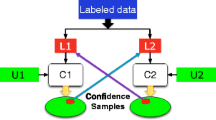Abstract
Mapping interesting regions in qualitative sidescan sonar imagery predominantly relies on an expensive human interpretation process. It would therefore be useful to automate components of this task with a feature-based, Machine Learning system. We must first establish a framework for reliably and efficiently evaluating the features. A novel ensemble of probabilistic distance measures is proposed, as an objective function for this purpose. The idea is motivated by the fact that different distance measures yield conflicting feature ranking results. In the ensemble, distances can be combined to produce a consensus rank score. As a test case, we find a sub-optimal parameterisation of a Co-occurrence Matrix, for identifying textures peculiar to the tube-building worm, Sabellaria spinulosa. A strong correlation is found between ensemble scores and classification accuracies. The proposed methodology is applicable to any sonar imagery, classification task or feature groups.
Access this chapter
Tax calculation will be finalised at checkout
Purchases are for personal use only
Preview
Unable to display preview. Download preview PDF.
Similar content being viewed by others
References
Limpenny, D., Foster-Smith, R., Edwards, T., Hendrick, V., Diesing, M., Eggleton, J., Meadows, W., Crutchfield, Z., Pfeifer, S., Reach, I.: Best methods for identifying and evaluating Sabellaria spinulosa and cobble reef. Aggregate Levy Sustainability Fund Project MAL0008
Samiee, K., Rad, G.: Textural Segmentation of Sidescan Sonar Images Based on Gabor Filters Bank and Active Contours without Edges. In: IEEE Fifth International Conference on Advanced Video and Signal Based Surveillance. AVSS 2008, pp. 3–8 (2008)
Wang, Y., Liu, Z., Sang, E., Ma, H.: Sonar image classification based on directional wavelet and fuzzy fractal dimension. In: 2nd IEEE Conference on Industrial Electronics and Applications, ICIEA 2007, pp. 118–120. IEEE, Los Alamitos (2007)
Karoui, I., Fablet, R., Boucher, J., Pieczynski, W., Augustin, J.: Fusion of textural statistics using a similarity measure: application to texture recognition and segmentation. Pattern Anal. Appl. 11(3), 425–434 (2008)
Reed, T., Hussong, D.: Digital image processing techniques for enhancement and classification of SeaMARC II side scan sonar imagery. J. Geophys. Res. 94(B6), 7469–7490 (1989)
Blondel, P., Gómez Sichi, O.: Textural analyses of multibeam sonar imagery from Stanton Banks, Northern Ireland continental shelf. Appl. Acoust. 70(10), 1288–1297 (2009)
Guyon, I., Elisseeff, A.: An introduction to variable and feature selection. The J. Mach. Learn. Res. 3, 1157–1182 (2003)
Cha, S.: Comprehensive survey on distance/similarity measures between probability density functions. Int. J. Math. Model. Method. Appl. Sci. 4(1), 300–307 (2007)
Pearce, B.: Thanet Offshore Wind Farm Benthic and Intertidal Resource Survey, Section III - Sabellaria Distribution (2005)
Webb, A.: Statistical pattern recognition. John Wiley and Sons Ltd., Chichester (1999)
Bhattacharyya, A.: On a measure of divergence between two statistical populations defined by their probability distributions. Bull. Calcutta Math. Soc. 35(99-109), 4 (1943)
Petrou, M., Sevilla, P.: Image processing: dealing with texture. John Wiley & Sons Inc., Chichester (2006)
Haralick, R., Shanmugam, K., Dinstein, I.: Textural features for image classification. IEEE T. Syst. Man Cy. 3(6), 610–621 (1973)
Vapnik, V.: The Nature of Statistical Learning Theory. Springer, New York (1998)
Author information
Authors and Affiliations
Editor information
Editors and Affiliations
Rights and permissions
Copyright information
© 2011 Springer-Verlag Berlin Heidelberg
About this paper
Cite this paper
Harrison, R., Birchall, R., Mann, D., Wang, W. (2011). A Novel Ensemble of Distance Measures for Feature Evaluation: Application to Sonar Imagery. In: Yin, H., Wang, W., Rayward-Smith, V. (eds) Intelligent Data Engineering and Automated Learning - IDEAL 2011. IDEAL 2011. Lecture Notes in Computer Science, vol 6936. Springer, Berlin, Heidelberg. https://doi.org/10.1007/978-3-642-23878-9_39
Download citation
DOI: https://doi.org/10.1007/978-3-642-23878-9_39
Publisher Name: Springer, Berlin, Heidelberg
Print ISBN: 978-3-642-23877-2
Online ISBN: 978-3-642-23878-9
eBook Packages: Computer ScienceComputer Science (R0)




